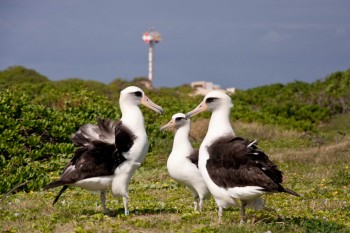A series of short presentations entitled "Seabirds at the crossroads: Perspectives, Challenges and Solutions" touching on various aspects of seabird conservation with a focus on multiple disciplines and the potential for synergistic collaborations will be held all over the space of an hour on Sunday 4 September at the IUCN World Conservation Congress taking place this week in the Hawaiʻi Convention Center, Honolulu, Oahu, Hawaii, USA.
“Seabirds breed on land, feed at sea, and cover vast distances, often crossing entire ocean basins. These characteristics require conservation approaches that are holistic and based on multiple disciplines. This event will highlight conservation challenges and cutting-edge solutions grounded in biology, economics, governance, and sociology. Because of their highly migratory nature, seabird conservation solutions provide spill-over benefits to the marine ecosystems as a whole.”

Laysan Albatrosses at Hawaii's Kaena Point, photograph by Lindsay Young
A list of the speakers and their presentation titles follows:
Seabirds at the crossroads: perspectives, challenges and solutions - Lisa Ballance
Global and regional priorities for seabird conservation - Kyle Van Houtan
Feathered oceanographers: seabirds as bio-indicators - David Hyrenbach
Seabirds: part of the ocean’s “benefits package” - Summer Martin
Racing climate change to the crossroads - David Duffy & Beth Flint
Restoration science: combining passive and active seabird restoration techniques – Lindsay Young
Fisheries technology: mitigating unintended mortality - Eric Gilman
Economics: incentives-based approaches to mitigate bycatch - Dale Squires
Fisheries management: seabirds competing for food with fisheries? - Charlotte Boyd
Governance: has progress stalled in protecting seabirds through Regional Fisheries Management Organizations? - Karen Baird
Sociology: community-based solutions for lasting stewardship - Michelle Hester
Communications: do seabirds have a PR problem? - Chris Gaskin
Seabirds at the crossroads: where do we go from here? - Eileen Sobeck
John Cooper, ACAP Information Officer, 31 August 2016

 English
English  Français
Français  Español
Español